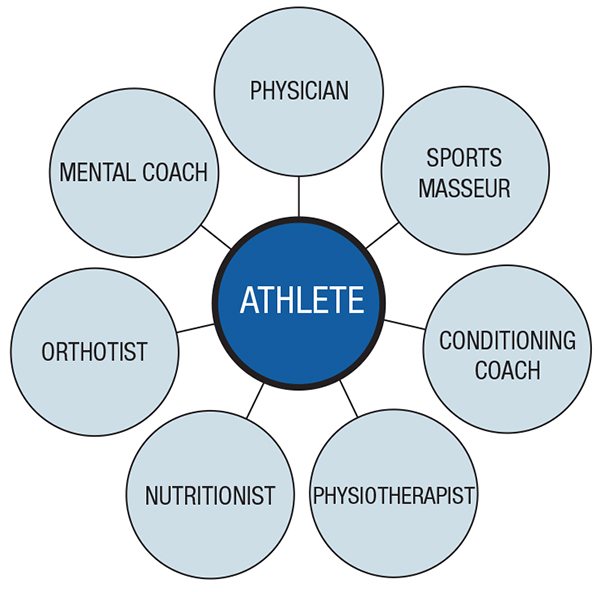The recent achievements of Indian athletes in international arenas have added fresh vigour to the possibility of India becoming a sporting superpower. The ambition, however, requires introduction of a new discipline to medicine—Sports Medicine.
This area of medicine looks at the performance of athletes and enables them to reach their full potential.
Athletes and coaches have realised the value of a specialised medical team that understands the demands of their particular sport, accelerates the recovery of injured/recovering athletes and maximises the athletic ability of sportsmen.

This is how it works: The team agrees on a suitable programme for the athlete; and each team member plays a specific role to ensure that every element of recovery and performance is covered. With performance being the ultimate goal, one can’t ignore the five essential elements of human performance for a well balanced programme.
If these elements are managed well, the athletes will be able to reach their full potential. If sufficient emphasis is not present in a given area, the programme would end up as being ‘weak’, resulting in poor performance of athletes.
Whether it is a weekend warrior or an athlete, the Sports Medicine Centre will help you plan your path to maximise your potential. While it aims to develop programmes that produce best results, the centre also caters to anyone who has a biomechanical problem or who wishes to reach his/her full athletic potential.
At KDAH, we have sports physicians, physiotherapists and orthotists who cover a wide variety of conditions. The sports physician specialises in assessment and medical management, and recommends appropriate rehabilitation depending on the nature of injury. While the sports physiotherapist is an expert in manual therapy, he also plays a role in joint mobilisation, soft tissue manipulation and exercise rehabilitation. The main function is to restore normal biomechanics and enhance mechanics to their very best. The orthotist specialises in making moulds that fit into an athlete’s shoes, helping him/her to have better biomechanics of feet and ankles and enhance the athletic ability through improved ground reaction force control and utilisation.

In future, KDAH plans to have services like sports psychology to help athletes with aspects such as goal setting, visualisation and intensity maintenance techniques. Areas such as focus and planning will be a huge part of the service package. Deep tissue sports massage will be another valuable service designed to help with athletes’ recovery. In addition, there are plans for a nutrition management programme that plays a huge part in the recovery programme.
Our Centre of Sports Medicine has one of the largest sports rehabilitation gymnasiums in India and we offer comprehensive sports rehab services in the areas of balance, stability, proprioception, flexibility, stamina, strength, endurance, speed and agility. The sports rehabilitation and performance enhancement service has a dedicated area with a trained multi-disciplinary
team and state-of-the-art technology to manage and rehabilitate persons with sports injuries.
THE TECHNOLOGY AND SERVICES OFFERED ARE:
Gait and Motion Analysis Laboratory
The first-of-its-kind in a corporate set up in India, the analysis helps in diagnosing abnormal gait and movement patterns, evaluating underlying causes and in targeting treatment strategies and corrective action.
Multi-joint Dynamometer with Work Simulator
The Multi-joint Dynamometer can measure muscle strength of any major muscle group in three different modes: isokinetic, isotonic and isometric. This assessment helps in designing individualised rehabilitation programmes and strength training schedules for sportspersons; and specifically targeting isolated weaker muscle groups. The training can be initiated in the early stage of the injury on the machine using isokinetic mode to reduce the impact on the joint.c
Human Performance Evaluation (VO2 max)
VO2 max (Maximal Oxygen Consumption or Maximum Aerobic Capacity) is the maximum capacity of an individual’s body to transport and utilise oxygen during incremental exercise, which reflects the physical fitness of the individual
Balance Assessment and Training System (BATS)
Proprioceptive deficits are a common sequelae of sport injuries hampering early return of function. Prioceptive deficits cause improper weight shift/bearing leading to impaired balance, which is key prerequisite in sports performance. Balance Master is one-ofits-kind machine to help in both proprioceptive/balance assessment as well as training. Individual training depends on the assessment targeting specific plane or the range of affected joint movements.
Fitness Testing
Whether it is a professional athlete or a weekend warrior, we will conduct a detailed set of fitness tests, to be able to conclude how fit an athlete is and how he/she stands in comparison to high-level and average athletes in a particular sport. Strength and conditioning programmes are tailored on the basis of the results of these tests.
Electrotherapy
The types of physical modalities for effective pain relief after sports injury are:
- Shortwave and microwave diathermy
- Laser and therapeutic ultrasound
- Paraffin bath
- Transcutaneous electric nerve stimulation
Aqua Treadmill
Water buoyancy (weightlessness) while walking on the treadmill provides gait training, balance enhancement and confidence for patients and athletes. Therefore a treadmill submerged in water provides exercise for sports person.
Warm water relaxes tight muscles and enhances release of endorphins (natural painkillers); surface tension and resistance to water help strengthen specific muscles and improve balance of patients; hydrostatic pressure is beneficial for cardiopulmonary fitness.
TWO TYPES OF BIOMECHANICAL ASSESSMENTS CONDUCTED AT THE CENTRE:
- Regional Assessment:
This is done when a client has a particular problem, like a twisted ankle or a painful elbow. - Full Biomechanical Assessment:
Starting at the feet and ending at the base of the skull, this assessment is conducted when multiple regions of the body involved. This would be the case for many hip, back, neck and shoulder problems. This assessment aims to identify the biomechanical patterns of weakness in the body, just so detailed rehabilitation programmes can be tailored for individual needs.
 Back to Site
Back to Site